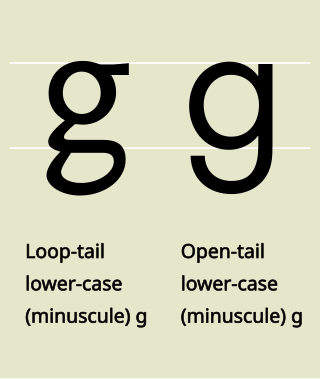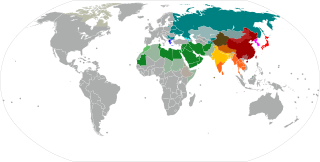
In linguistics, a grapheme is the smallest functional unit of a writing system. The word grapheme is derived from Ancient Greek γράφω (gráphō) 'write' and the suffix -eme by analogy with phoneme and other names of emic units. The study of graphemes is called graphemics. The concept of graphemes is abstract and similar to the notion in computing of a character. By comparison, a specific shape that represents any particular grapheme in a given typeface is called a glyph.

A glyph is any kind of purposeful mark. In typography, a glyph is "the specific shape, design, or representation of a character". It is a particular graphical representation, in a particular typeface, of an element of written language. A grapheme, or part of a grapheme, or sometimes several graphemes in combination can be represented by a glyph.
The following outline is provided as an overview and topical guide to linguistics:
An orthography is a set of conventions for writing a language, including norms of spelling, hyphenation, capitalization, word boundaries, emphasis, and punctuation.
In linguistics and specifically phonology, a phoneme is any set of similar phones that, within a given language, is perceptually regarded as a single distinct sound and helps distinguish one word from another.
Phonology is the branch of linguistics that studies how languages systematically organize their phones or, for sign languages, their constituent parts of signs. The term can also refer specifically to the sound or sign system of a particular language variety. At one time, the study of phonology related only to the study of the systems of phonemes in spoken languages, but may now relate to any linguistic analysis either:
Linguistics is the scientific study of language, involving analysis of language form, language meaning, and language in context.
Han unification is an effort by the authors of Unicode and the Universal Character Set to map multiple character sets of the Han characters of the so-called CJK languages into a single set of unified characters. Han characters are a feature shared in common by written Chinese (hanzi), Japanese (kanji), Korean (hanja) and Vietnamese.

A written language is the representation of a language by means of writing. This involves the use of visual symbols, known as graphemes, to represent linguistic units such as phonemes, syllables, morphemes, or words. However, written language is not merely spoken or signed language written down, though it can approximate that. Instead, it is a separate system with its own norms, structures, and stylistic conventions, and it often evolves differently than its corresponding spoken or signed language.

In graphemics and typography, the term allograph is used of a glyph that is a design variant of a letter or other grapheme, such as a letter, a number, an ideograph, a punctuation mark or other typographic symbol. In graphemics, an obvious example in English is the distinction between uppercase and lowercase letters. Allographs can vary greatly, without affecting the underlying identity of the grapheme. Even if the word "cat" is rendered as "cAt", it remains recognizable as the sequence of the three graphemes ⟨c⟩, ⟨a⟩, ⟨t⟩.

Complex text layout (CTL) or complex text rendering is the typesetting of writing systems in which the shape or positioning of a grapheme depends on its relation to other graphemes. The term is used in the field of software internationalization, where each grapheme is a character.

In linguistics, a segment is "any discrete unit that can be identified, either physically or auditorily, in the stream of speech". The term is most used in phonetics and phonology to refer to the smallest elements in a language, and this usage can be synonymous with the term phone.

A letterform, letter-form or letter form, is a term used especially in typography, palaeography, calligraphy and epigraphy to mean a letter's shape. A letterform is a type of glyph, which is a specific, concrete way of writing an abstract character or grapheme.

In sociolinguistics, digraphia refers to the use of more than one writing system for the same language. Synchronic digraphia is the coexistence of two or more writing systems for the same language, while diachronic digraphia is the replacement of one writing system by another for a particular language.
Graphemics or graphematics is the linguistic study of writing systems and their basic components, i.e. graphemes.
Linguistics is the scientific study of language. Linguistics is based on a theoretical as well as a descriptive study of language and is also interlinked with the applied fields of language studies and language learning, which entails the study of specific languages. Before the 20th century, linguistics evolved in conjunction with literary study and did not employ scientific methods. Modern-day linguistics is considered a science because it entails a comprehensive, systematic, objective, and precise analysis of all aspects of language – i.e., the cognitive, the social, the cultural, the psychological, the environmental, the biological, the literary, the grammatical, the paleographical, and the structural.

A writing system comprises a particular set of symbols, called a script, as well as the rules by which the script represents a particular language. Writing systems can generally be classified according to how symbols function according to these rules, with the most common types being alphabets, syllabaries, and logographies. Alphabets use symbols called letters that correspond to spoken phonemes. Abjads generally only have letters for consonants, while pure alphabets have letters for both consonants and vowels. Abugidas use characters that correspond to consonant–vowel pairs. Syllabaries use symbols called syllabograms to represent syllables or moras. Logographies use characters that represent semantic units, such as words or morphemes.
The orthographic depth of an alphabetic orthography indicates the degree to which a written language deviates from simple one-to-one letter–phoneme correspondence. It depends on how easy it is to predict the pronunciation of a word based on its spelling: shallow orthographies are easy to pronounce based on the written word, and deep orthographies are difficult to pronounce based on how they are written.

Umlaut is a name for the two dots diacritical mark as used to indicate in writing the result of the historical sound shift due to which former back vowels are now pronounced as front vowels.
In linguistics and related fields, an emic unit is a type of abstract object. Kinds of emic units are generally denoted by terms with the suffix -eme, such as phoneme, grapheme, and morpheme. The term "emic unit" is defined by Nöth (1995) to mean "an invariant form obtained from the reduction of a class of variant forms to a limited number of abstract units". The variant forms are called etic units. This means that a given emic unit is considered to be a single underlying object that may have a number of different observable "surface" representations.








